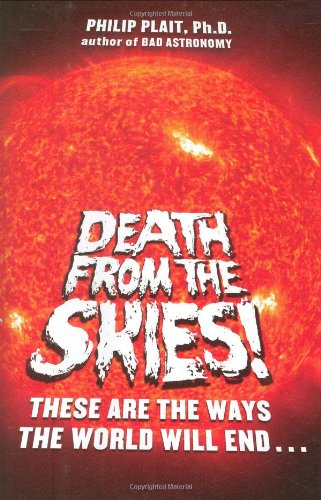

| DEATH FROM THE SKIES! These are the Ways the World Will End Philip Plait New York: Viking Penguin, October 2008 |
Rating: 5.0 High |
|||
| ISBN-13 978-0-670-01997-7 | ||||
| ISBN 0-670-01997-6 | 326pp. | HC/BWI | $25.95 | |
At the start of this book, astronomer Phil Plait declares:
He's right, of course.1 And through nine chapters — each beginning with a dramatized scenario — he proceeds to describe the manifold ways in which the universe might deliver this Death from the Skies.
The possibilities range from the fairly mundane (asteroid impacts) through solar flares and the evolution of the Sun into a red giant to really exotic dangers: Black holes, gamma-ray bursts and the eventual heat-death of the universe. Some of these are inevitable; others are matters of chance; and the worst are purely theoretical at this point. Doctor Plait explains them in scientifically valid but accessible terms, each explanation beginning with a dramatized scenario to make the danger vivid.
But do not make the mistake of worrying that any of these scenarios is likely to come to pass in our lifetimes. Doctor Plait makes it clear that they are either low-probability occurrences or, if inevitable, are far off in time — billions of years off in the case of the inevitable expansion of the Sun into a planet-devouring red giant. In his Epilogue, he presents a table showing the potential damage from each event, the probability of fatality during one lifetime, and what might be done to prevent deaths.
For example, the impact of a significant asteroid (of "city-buster" size or larger)2 has a chance of 1 in 700,000 of killing anyone in the United States during their lifetime. This, says Plait, is "somewhat less than being killed in a fireworks accident." Also worth remembering are the facts that we know how to prevent asteroid impacts and will have the capability to do so in a few years.3
The clear and very readable text is supplemented by 30 black-and-white photographs and several diagrams, and enlivened by typical Plait humor. I was impressed by the amount of astrophysical detail, especially in the chapter on the death of the Sun, where Doctor Plait bases his account on computer models of stellar evolution. However, mindful of his audience, he avoids jargon and minimizes the use of equations. (Scientific notation is required, of course, to handle the enormous quantities discussed.) An Appendix listing nearby supernova-capable stars and a good Index are included. There are few grammatical errors. I give this full marks and rate it a keeper.

 To contact Chris Winter, send email to this address.
To contact Chris Winter, send email to this address.